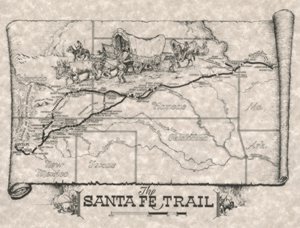A long lush memory is embedded in the windswept plains, on the mesa tops and in the secluded mountain canyons of northeast New Mexico. The land has kept a careful record of tracks and trails to present a multi-generational morality play, the ultimate American Western.
Northeast New Mexico is a history lesson of what happens when two empires meet. The older north-south Spanish Empire ended in Santa Fe and the younger, brasher east-west American Empire reached no further than Independence, Missouri. A grand 600-mile prairie lay in between, with mountains to pass and rivers to ford. Wagon after wagon would follow the Santa Fe Trail, leaving a legacy of tracks that can still be seen today.
The rumble of freight wagons, the shout of the bullwhacker, the snap of the whip, the bellow of oxen, the quiet conversations in Spanish and English. These are the trail sounds that evoke the pioneer spirit.
After all these years, the Santa Fe Trail still stirs the emotions. A flawless sky of deep blue, as big as an A.B. Guthrie novel, above a prairie that seems to roll forever. Caravans of commerce plodding westward to river crossings of rushing torrents and dry washes. The choking, blinding dust and sudden chill of the wind. The throaty thunder of approaching storms. The furtive glances for the lurking presence of Pawnees and Comanches. The blare of bugles, the crack of rifle fire, the endless brown seas of buffalo.
Today, the remnants of the trail await the traveler at scores of sites, great and small, across five states and much of Northeast New Mexico's Union, Colfax, Mora and San Miguel counties. Private landowners, nonprofit groups and federal, state and local agencies manage most Trail resources. Look for the distinctive signs that mark the auto tour that parallels the Trail.
How It All Started: When William Becknell left Old Franklin, Missouri, on September 1, 1821, heading west to trade with the Indians, he had little luck. But in New Mexico he encountered some Spanish dragoons. Instead of taking him prisoner for having entered Spanish Colonial Territory illegally, the soldiers urged him to bring his goods to Santa Fe.
Becknell arrived there on November 16, quickly sold his wares and hurried back to Missouri, his mules laden with silver coins. Mexico had declared its independence from Spain, and American traders were now welcome in Santa Fe.
Within weeks, Becknell had organized another expedition. This time he took wagons crammed with $3,000 worth of trade goods. His profit in Santa Fe was 2,000 percent. The Santa Fe Trail was born, and a new era of prosperity began. For New Mexico, the trail brought ever-increasing supplies of less expensive goods from the eastern United States. As the caravans of commerce rolled west, they brought to New Mexico not only new people, but a new language, skills and customs.
The trail at first led 909 miles through five states to Santa Fe, the capital of New Mexico. As the American frontier crept westward, it became progressively shorter.
Although the trail at first attracted adventurers and mountain men, its typical travelers were businessmen. They financed hundreds of caravans of freight wagons hauled by thousands of mules and oxen.
Often travel was just 12 to 15 miles a day. Yet merchants risked wagon accidents, disease and Indian attacks. They weathered drought, storms and floods. After all, there were profits to be made.
When the United States declared war against Mexico in 1846, U.S. troops took the trail to declare New Mexico a United States Territory. In the following years, as trade grew, several forts were built to protect trail traffic.
Trail trade flourished. In 1866, traffic peaked at 5,000 freight wagons. But the railroad had reached eastern Kansas and as its tracks crept westward, trail traffic dwindled. In 1879, when the first locomotive steamed into New Mexico, the Santa Fe Trail was history.
Visit the Clayton-Union County Chamber of Commerce/Tourist Information Center, 1103 South First St. in Clayton for detailed brochures and maps on the Santa Fe Trail.
|
 |